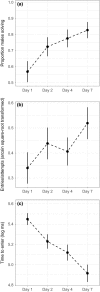The relationship between male sexual signals, cognitive performance, and mating success in stickleback fish
- PMID: 28808542
- PMCID: PMC5551085
- DOI: 10.1002/ece3.3091
The relationship between male sexual signals, cognitive performance, and mating success in stickleback fish
Abstract
Cognitive ability varies dramatically among individuals, yet the manner in which this variation correlates with reproduction has rarely been investigated. Here, we ask (1) do male sexual signals reflect their cognitive ability, and (2) is cognitive ability associated with male mating success? Specifically, we presented threespine sticklebacks (Gasterosteus aculeatus) with a detour-reaching task to assess initial inhibitory control. Fish that performed better were those who solved the detour-reaching task, solved it faster, and required fewer attempts to solve. We then reexamined males' performance on this task over several days to assess learning ability in this context. We next measured sexual signals (coloration, nest area, and courtship vigor) and asked whether they reveal information about these male cognitive abilities. Finally, we examined whether success at attracting a female is associated with male cognition. After controlling for the strong effect of neophobia, we found that no measured sexual signals were associated with initial inhibitory control. Sexual signals were also not associated with change in performance on the detour-reaching task over time (learning). However, females preferred mating with males who had better initial inhibitory control. We speculate that inhibitory control is a critical trait for male sticklebacks. In this system, males perform all parental care, but must avoid eating their own fry which closely resemble their prey items. Therefore, males with better inhibitory control may be more likely to successfully raise their offspring to independence. Our research adds to a growing list of mating systems and taxa in which cognition is important for measures related to fitness.
Keywords: cognition; detour‐reaching task; female choice; inhibitory control; learning; sexual selection; sexual signal; threespine stickleback.
Figures



Similar articles
-
Sex differences in cognition and their relationship to male mate choice.Curr Zool. 2019 Jun;65(3):285-293. doi: 10.1093/cz/zoz014. Epub 2019 Apr 2. Curr Zool. 2019. PMID: 31263487 Free PMC article.
-
Smart mating: the cognitive ability of females influences their preference for male cognitive ability.Behav Ecol. 2021 Jun 22;32(5):803-813. doi: 10.1093/beheco/arab052. eCollection 2021 Sep-Oct. Behav Ecol. 2021. PMID: 34690544 Free PMC article.
-
Female stickleback prefer shallow males: Sexual selection on nest microhabitat.Evolution. 2015 Jun;69(6):1643-1653. doi: 10.1111/evo.12682. Epub 2015 Jun 5. Evolution. 2015. PMID: 25958935
-
Glucocorticoids, male sexual signals, and mate choice by females: Implications for sexual selection.Gen Comp Endocrinol. 2020 Mar 1;288:113354. doi: 10.1016/j.ygcen.2019.113354. Epub 2019 Dec 9. Gen Comp Endocrinol. 2020. PMID: 31830474 Review.
-
An integrative view of sexual selection in Tribolium flour beetles.Biol Rev Camb Philos Soc. 2008 May;83(2):151-71. doi: 10.1111/j.1469-185X.2008.00037.x. Biol Rev Camb Philos Soc. 2008. PMID: 18429767 Review.
Cited by
-
Inhibitory control in teleost fish: a methodological and conceptual review.Anim Cogn. 2024 Mar 26;27(1):27. doi: 10.1007/s10071-024-01867-5. Anim Cogn. 2024. PMID: 38530456 Free PMC article. Review.
-
Male and female cichlid fish show cognitive inhibitory control ability.Sci Rep. 2019 Oct 31;9(1):15795. doi: 10.1038/s41598-019-52384-2. Sci Rep. 2019. PMID: 31673023 Free PMC article.
-
The sexual selection of creativity: A nomological approach.Front Psychol. 2023 Jan 9;13:874261. doi: 10.3389/fpsyg.2022.874261. eCollection 2022. Front Psychol. 2023. PMID: 36698589 Free PMC article. Review.
-
Linking individual fitness to the evolution of cognition.Philos Trans R Soc Lond B Biol Sci. 2025 Jun 26;380(1929):20240122. doi: 10.1098/rstb.2024.0122. Epub 2025 Jun 26. Philos Trans R Soc Lond B Biol Sci. 2025. PMID: 40566913 Review.
-
Are lateralized and bold fish optimistic or pessimistic?Anim Cogn. 2024 Jun 4;27(1):42. doi: 10.1007/s10071-024-01876-4. Anim Cogn. 2024. PMID: 38833197 Free PMC article.
References
-
- Albert, A. Y. K. , Millar, N. P. , & Schluter, D. (2007). Character displacement of male nuptial colour in threespine sticklebacks (Gasterosteus aculeatus) . Biological Journal of the Linnean Society, 91, 37–48.
-
- Amici, F. , Aureli, F. , & Call, J. (2008). Fission‐fusion dynamics, behavioral flexibility, and inhibitory control in primates. Current Biology, 18, 1415–1419. https://doi.org/10.1016/j.cub.2008.08.020 - DOI - PubMed
-
- Anderson, R. C. , Searcy, W. A. , Peters, S. , Hughes, M. , DuBois, A. L. , & Nowicki, S. (2016). Song learning and cognitive ability are not consistently related in a songbird. Animal Cognition, 20, 309–320. - PubMed
-
- Bates, D. , Maechler, M. , Bolker, B. , & Walker, S. (2013). Lme4: Linear Mixed‐Effects Models Using Eigen and S4. R Package Version 1.0‐5. Retrieved from http://CRAN.R-project.org/package=lme4/ (last accessed 17 November 2016).
Associated data
LinkOut - more resources
Full Text Sources
Other Literature Sources
Molecular Biology Databases

